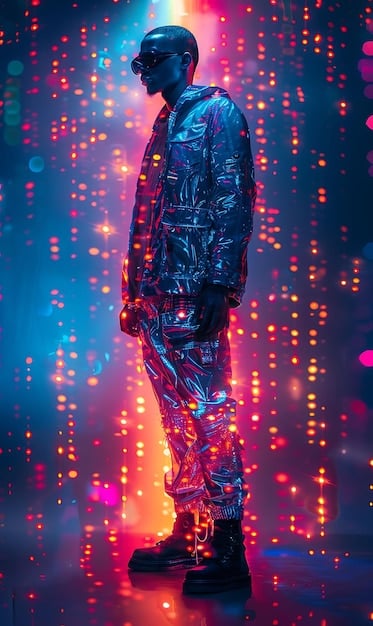The Metaverse Wardrobe: Digital Fashion Trends to Watch

Anúncios
The metaverse wardrobe revolutionizes fashion by enabling digital-only wear, offering unique opportunities for creativity, sustainability, and personal expression through NFTs and AI-driven designs, fundamentally reshaping how we interact with clothing in virtual immersive environments.
The concept of The Metaverse Wardrobe: Digital Fashion Trends to Watch represents a significant evolution in how we perceive and interact with clothing. No longer confined to physical garments, fashion is now expanding into dynamic, digital realms, offering unprecedented avenues for creativity and self-expression. This digital frontier promises to redefine ownership, sustainability, and personal style, creating a vibrant new ecosystem for the apparel industry.
The Dawn of Digital Fashion: More Than Just Pixels
Digital fashion, at its core, is the creation and application of clothing exclusively in virtual spaces. This isn’t merely about dressing an avatar; it’s about crafting wearable art that defies the limitations of the physical world. Imagine garments that shimmer with impossible luminosity, change color with your mood, or float effortlessly around your digital persona. These are the possibilities that digital fashion unlocks, moving beyond simple aesthetics to a truly immersive experience.
The appeal of digital fashion extends far beyond novelty. It offers a canvas for designers to experiment without the constraints of material costs, production scales, or even gravity. This freedom fosters unparalleled innovation, leading to designs that would be impossible or impractical in the physical world. We’re witnessing the rise of a new breed of fashion designers, fluent in 3D modeling, animation, and game design, who are pushing the boundaries of what clothing can be.
Beyond the Runways: Early Adoption and Impact
Initial forays into digital fashion have already made waves. Gaming platforms were early adopters, allowing players to customize their characters with unique skins and outfits. Luxury brands are now entering the fray, recognizing the metaverse as a critical new market. These early moves showcase a clear trajectory towards mainstream acceptance.
- Gaming’s influence: How digital skins paved the way for metaverse fashion.
- Luxury brand adaptation: High-end labels experimenting with virtual collections.
- Early examples: Iconic digital garments and their real-world value.
As technology advances, so too does the sophistication of digital garments. Photorealistic textures, dynamic draping, and interactive elements are becoming standard, blurring the line between digital and physical reality. The conversation is shifting from “why digital clothes?” to “what incredible things can we do with digital clothes that we can’t do anywhere else?”
The transformative power of digital fashion lies in its capacity for democratic access. While luxury physical items remain exclusive, digital counterparts can potentially be more widely distributed, allowing a broader audience to engage with high fashion concepts. This accessibility not only diversifies the consumer base but also fosters a more inclusive fashion landscape.
NFTs and Blockchain: The Fabric of Digital Ownership
One of the most revolutionary aspects intertwining with the metaverse wardrobe is the role of Non-Fungible Tokens (NFTs) and blockchain technology. NFTs provide undeniable proof of ownership for digital assets, including clothing. This seemingly abstract concept is fundamental to establishing value, rarity, and authenticity in the digital fashion economy. Without NFTs, digital items would be infinitely replicable, undermining their perceived worth.
Blockchain technology, the underlying infrastructure for NFTs, ensures transparency and immutability. Every transaction, every ownership transfer of a digital garment, is recorded on a decentralized ledger. This not only prevents counterfeiting but also creates a verifiable history for each item, giving it provenance in the same way physical luxury goods have authenticated histories. This digital provenance is crucial for building trust and liquid markets for digital fashion assets.
The Value Proposition of Digital Assets
Why would someone pay significant sums for a digital garment? The value proposition is multifaceted. Firstly, it’s about expression and identity in virtual worlds, where our digital avatars are extensions of ourselves. Just as we use physical clothes to communicate who we are, digital clothes serve a similar purpose in the metaverse. Secondly, digital fashion can be a speculative asset, similar to physical collectibles or art, with value appreciating based on rarity, designer, and demand.
- Scarcity by design: How limited edition NFTs drive demand.
- Digital flexing: The social status associated with unique digital wearables.
- Resale markets: The burgeoning ecosystem for trading digital fashion.
The concept of “wearing” digital clothes goes beyond just aesthetics. Some platforms allow digital fashion to be “worn” in augmented reality (AR), overlaying the digital garment onto a physical person via a smartphone camera. This blurs the lines between virtual and reality even further, offering a glimpse into a future where our digital wardrobe is directly visible in our physical world.
The legal and ethical frameworks surrounding digital ownership are still evolving, particularly concerning intellectual property rights and the resale of NFT fashion items. As the market matures, clearer guidelines will emerge, further solidifying the foundations of this new digital economy. This will ultimately provide greater confidence for both creators and consumers in the long term.
AI-Driven Design and Personalization: A New Era of Creation
Artificial intelligence (AI) is set to revolutionize the creation and personalization of digital fashion within the metaverse. Imagine AI algorithms analyzing your digital twin’s body shape, style preferences, and even your mood to generate unique clothing designs tailored specifically for you. This level of hyper-personalization is far beyond what’s currently achievable in traditional fashion. AI can also assist designers by generating novel patterns, textures, and silhouettes, accelerating the creative process and pushing boundaries.
From concept generation to material simulation, AI tools are becoming indispensable. These tools can predict trends, optimize designs for digital rendering, and even simulate how different fabrics would drape and move in a virtual environment. This predictive power allows designers to be more efficient and innovative, reducing the time from concept to digital product.
Customization and Hyper-Personalization
The metaverse promises a level of personal expression previously unimaginable. AI can facilitate this by allowing users to not just choose pre-designed digital garments, but to co-create them. Think about an AI assistant that understands your aesthetic and helps you design bespoke outlines, patterns, and features for your digital self. This democratizes the design process, making everyone a potential co-creator.
- Generative AI: Creating unique garments from textual prompts.
- Algorithmic personalization: Tailoring outfits based on user data.
- Virtual try-on: AI-powered tools allowing realistic digital fitting.
AI is also proving essential for scaling digital fashion. While a single human designer can only produce so many unique pieces, AI can generate countless iterations, allowing for a broader, more diverse range of digital apparel. This capability is vital for meeting the demand of a continuously expanding metaverse population.
The ethical implications of AI in design, particularly regarding intellectual property and data privacy, remain important considerations. As these technologies become more integrated into the fashion ecosystem, robust frameworks will be needed to ensure fairness and transparency. The goal is to empower creativity, not stifle it.
Sustainability in the Digital Realm: A Green Promise?
One of the most compelling arguments for the rise of digital fashion is its potential for unprecedented sustainability. The traditional fashion industry is notoriously resource-intensive, contributing significantly to pollution, waste, and carbon emissions. Digital fashion, by existing entirely in the virtual realm, offers a stark contrast. There are no physical materials to produce, no factories to run, no logistics for shipping, and virtually no waste generated from unsold inventory.
This inherent lack of physical footprint means that digital fashion could be a powerful tool in reducing the environmental impact of our consumption habits. Instead of constantly buying new physical garments, consumers could satisfy their desire for novelty and expression through their metaverse wardrobe, reducing the pressure on finite resources. This shift represents a paradigm change in sustainable consumption.
The Nuances of Digital Sustainability
While digital fashion is inherently more sustainable than its physical counterpart, it’s not entirely without an environmental cost. The creation, storage, and transaction of digital assets, especially NFTs, consume energy. The blockchain networks that underpin these technologies require significant computational power, which translates to energy usage.
- Energy consumption of NFTs: Understanding the carbon footprint of blockchain.
- Greener chains: The shift towards more sustainable blockchain technologies.
- Reduced physical waste: How digital fashion minimizes landfill contributions.
However, the per-item environmental impact of digital fashion is still significantly lower than that of physical clothing. Furthermore, ongoing innovations in blockchain technology are focusing on more energy-efficient consensus mechanisms (like Proof-of-Stake vs. Proof-of-Work), which promise to drastically reduce the carbon footprint of digital transactions. Ultimately, digital fashion offers a compelling, albeit evolving, solution to the fashion industry’s environmental challenges.
The long-term vision is a fashion ecosystem where digital garments are the primary mode of expression, with physical garments reserved for core functional needs. This future could dramatically transform global manufacturing and retail, redirecting resources away from harmful processes towards more sustainable, digital-first models.

User-Generated Content and Creator Economy: Empowering the Community
The metaverse is not just a space for established brands; it’s a fertile ground for individual creators and user-generated content (UGC). This democratized approach to fashion design allows anyone with the right skills and vision to create, showcase, and monetize their digital garments. The barriers to entry are significantly lower than in traditional fashion, empowering a new generation of designers and fostering a truly diverse fashion landscape.
Platforms within the metaverse are emerging that provide tools for users to design their own clothing, from simple recolors to complex 3D models. These tools, often user-friendly, enable a vast array of creative expression. The “creator economy” model ensures that these digital artisans can earn revenue directly from their creations, bypassing traditional intermediaries.
The Rise of Independent Digital Designers
Independent digital designers are finding a voice and a market in the metaverse. They can build their own brands, connect directly with consumers, and create niche aesthetics that might not appeal to mass-market brands. This fosters a vibrant underground of fashion innovation, pushing stylistic boundaries and challenging conventional norms.
- Digital marketplaces: Platforms facilitating indie designer sales.
- Community feedback: How user communities shape design trends.
- Monetization models: Royalties, direct sales, and virtual events.
The collaborative nature of the metaverse also plays a crucial role. Designers can team up, share resources, and even co-create collections, fostering a sense of community and mutual growth. This collective energy fuels rapid innovation and diversity, ensuring that the metaverse wardrobe remains dynamic and ever-evolving.
The legal and ethical considerations around UGC, such as copyright protection for digital designs and preventing appropriation, are becoming increasingly important. As the volume of user-generated content explodes, robust frameworks will be needed to protect creators and maintain a fair playing field. This will ensure continued growth and innovation within the creator economy.
Challenges and the Road Ahead: Navigating the Digital Frontier
While the promise of the metaverse wardrobe is immense, several challenges need to be addressed for its widespread adoption and sustainable growth. Interoperability is a major hurdle: a digital garment purchased on one metaverse platform might not be wearable on another. This lack of seamless transition limits the utility and perceived value of digital assets. Establishing universal standards and protocols for digital fashion across different virtual worlds is crucial for a truly connected metaverse.
Another significant challenge is the underlying technology itself. The metaverse, in its full vision, requires powerful computing infrastructure and high-speed internet to deliver truly immersive and seamless experiences. Furthermore, widespread adoption relies on easy-to-use interfaces and intuitive experiences for the average consumer, many of whom are not familiar with blockchain technology or 3D environments.
Technological and User Adoption Barriers
The learning curve for many metaverse technologies can be steep. Understanding NFTs, navigating crypto wallets, and interacting with decentralized platforms can be daunting for newcomers. Simplifying these processes and making them more accessible will be key to attracting a broader audience beyond early adopters and tech enthusiasts.
- Metaverse integration: How fashion brands are bridging platforms.
- User experience (UX): Designing intuitive interfaces for digital fashion.
- Security concerns: Protecting digital assets from theft and fraud.
The speculative nature of the NFT market also presents a challenge. While some digital fashion items have fetched high prices, volatility and market fluctuations can deter potential investors and consumers. Building market stability and educating consumers about long-term value will be essential for sustained growth.
Finally, the perception of digital fashion needs to evolve. For many, it remains an abstract concept, seemingly less tangible than physical clothes. Overcoming this perception requires compelling use cases, mainstream media visibility, and a clear articulation of the benefits and value proposition of a metaverse wardrobe. The journey ahead is complex, but the momentum and innovation within the space suggest a bright future.

The Future is Fabricated: Embracing the Metaverse Wardrobe
The evolution of the metaverse wardrobe signifies more than just a technological shift; it represents a fundamental redefinition of fashion, identity, and commerce. As virtual worlds become increasingly sophisticated and integrated into our daily lives, our digital identities will gain parity, if not primacy, with our physical ones. The clothes we choose for our avatars will be as meaningful, if not more so, than the clothes we wear in offline spaces.
This future promises a fashion industry that is inherently more creative, sustainable, and democratic. Designers will be liberated from the constraints of the physical world, unleashing unprecedented artistic expression. Consumers will enjoy unparalleled customization and opportunities for self-expression, regardless of geographical or financial limitations. The sustainability benefits, while still needing careful energy management, offer a beacon of hope for an industry grappling with its environmental footprint.
Beyond Trends: A Transformative Landscape
The trends we observe today—NFTs, AI-driven design, UGC platforms—are merely the foundational layers of a far grander vision. The metaverse wardrobe will not simply offer digital versions of physical clothes; it will give rise to entirely new categories of apparel that are only possible in a virtual environment. Think about garments that respond to emotional states, clothes that interact with other digital objects, or even fashion that evolves organically based on your metaverse experiences.
- Interactive garments: Clothing that reacts to user input or environment.
- Dynamic fashion: Outfits that change appearance over time.
- Cross-platform fashion: Designing for multiple metaverses simultaneously.
As the metaverse becomes more interconnected, the concept of a singular “wardrobe” will expand to encompass not just individual pieces, but entire collections that seamlessly transition across various virtual domains. This interoperability will be crucial for the true flourishing of digital fashion, allowing users to move freely with their unique style intact.
The collaborative spirit between tech innovators, fashion designers, and consumers will accelerate this evolution. The future of fashion is undeniably digital, and the metaverse wardrobe is not just a trend to watch, but a transformative force that will reshape our understanding of clothing and self-expression for generations to come. The era of the truly fabricated future is here, inviting us all to dress for the digital age.
| Key Trend | Brief Description |
|---|---|
| 👗 Digital Wearables | Clothing designed exclusively for virtual environments, offering limitless creativity. |
| NFTs & Ownership | Blockchain technology providing verifiable ownership and authenticity for digital fashion assets. |
| 🤖 AI Design | Artificial intelligence enhancing garment creation, personalization, and trend prediction. |
| ♻️ Sustainability | Digital fashion’s potential to significantly reduce the environmental impact of apparel production. |
Frequently Asked Questions About The Metaverse Wardrobe
Digital fashion refers to clothing and accessories created purely for virtual environments or augmented reality. Unlike physical garments, these items exist only as digital files, worn by avatars or overlaid onto real people via technology, offering creative freedom without material constraints.
NFTs (Non-Fungible Tokens) provide unique, verifiable ownership for digital garments on a blockchain. This means when you “buy” a digital dress or suit, the NFT acts as its certificate of authenticity and proof of ownership, enabling rarity and resale in the metaverse.
Yes, digital fashion holds significant sustainability potential. It eliminates physical production, reducing waste, water usage, and carbon emissions associated with traditional manufacturing. While blockchain uses energy, its overall environmental footprint per item is far lower than physical clothing.
Digital fashion is created by a diverse group including traditional fashion houses, independent 3D artists, game designers, and individual users. With accessible tools and the rise of the creator economy, almost anyone can contribute to the metaverse wardrobe.
Key challenges include ensuring interoperability across different metaverse platforms, simplifying the user experience for general consumers, and managing the technological demands of realistic digital environments. Building trust and stable markets for digital assets are also crucial for widespread adoption.
Conclusion: Dressing the Digital Future
The metaverse wardrobe is rapidly evolving from a niche concept to a significant force poised to reshape the fashion industry entirely. It encapsulates a future where creativity is unbounded by physical limitations, where personal expression is amplified in virtual realms, and where sustainability gains a critical new dimension. While challenges like interoperability and user adoption remain, the pace of innovation within this space indicates a determined trajectory towards a future where our digital identities are as elaborately and thoughtfully adorned as our physical ones. The trends explored—from NFTs validating ownership to AI-driven personalization and the democratizing power of user-generated content—all point towards a dynamic, inclusive, and exciting digital fashion frontier. As we step deeper into immersive virtual experiences, understanding and engaging with our metaverse wardrobe will become not just a trend, but an essential aspect of modern self-identity.





